Impact of Inverter Based Resources on System Protection
Abstract
:1. Introduction
2. Short-Circuit Response of IBRs
- Fault current amplitude: The amplitude of the continuous fault current contributed by an IBR has a nonlinear dependence on inverter terminal voltage [29] and is typically low since it is constrained by the converter current limiter to values close to nominal load current. Table 1 presents the fault current contribution of an example Type IV-based IBR as a function of terminal voltage. Figure 1a compares the fault current of a SG, a Type III-, and a Type IV-based IBR for a given unbalanced fault. As shown, for the same induced short-circuit voltage, the positive-sequence current (I1) and I2 contributed by a Type IV IBR have the lowest amplitude, with amplitude of I1 being close to nominal load current and amplitude of I2 being close to zero. This low amplitude fault current may negatively impact the performance of protection functions using a supervising overcurrent element such as a distance relay.
- Fault sequence quantities: The inverter fault current does not include zero-sequence component (although zero-sequence current may still flow at the terminals of an IBR when connection to earth is provided by a transformer with a high-side, wye-grounded winding.) Further, I2 is typically partially or entirely suppressed depending on the inverter control [1]. Figure 1a shows that the I2 of a Type IV IBR is close to zero due to the nature of the traditional inverter coupled control scheme [3]. This lack of I2 may lead to protection misoperation problems, and hence grid codes have recently added requirements for IBR I2 injection during unbalanced faults. An example is the German grid code [28] which requires IBRs to inject a reactive I2 based on the characteristic curve of Figure 2 defined by a characteristic proportional gain k with a recommended value between 2 and 6. Figure 1a shows the impact of k = {2, 6} on the fault response of the Type IV IBR. As shown, I2 increases with the increased gain; nevertheless, I1 decreases since the total amplitude of the converter current is limited.
- Fault current power factor/phase angle: The fault current of an IBR has a dynamically changing phase angle depending on IBR control scheme and the amplitude of inverter terminal voltage, as shown in Table 1 [29]. Further, in contrast to a SG whose fault current is predominantly inductive, the fault current of an IBR may be either resistive, inductive, or capacitive. The control mode considerably impacts the angular relationship between on-fault voltages and currents near the IBR which is required by some protection functions (e.g., directional elements) for correct operation. Figure 1b compares the relative phase angle of I2 and negative-sequence voltage (V2) for a SG, a Type III-, and a Type IV-based IBR. As shown, for the SG and Type III IBR, I2 is predominantly inductive (i.e., I2 injected by the generator into the grid leads V2 by about 90°). However, the behavior is different under Type IV where I2 is predominantly capacitive (lagging V2 by about 90°). This changed angular characteristics may lead to misoperation of protection functions relying on the phase angle of I2/V2 for proper operation. The paper provides examples of such misoperation problems. This could be addressed by reactive I2 injection, e.g., based on the German grid code, in which case the phase angle becomes predominantly inductive, as shown in Figure 1b for k = {2, 6}.
- Fault current duration: The amount of time an inverter can continuously inject overcurrent into the grid during a fault depends on the inverter control and thermal limits of the power electronics.
- Rate of change of frequency: IBRs have no inherent rotational inertia (some grid codes mandate that wind generators have the capability to provide a synthetic inertial response [30]). Hence, large-scale integration of IBRs is expected to increase the rate of change of system frequency following large system disturbances such as loss of a major generation infeed. Furthermore, faster power swings are expected under high shares of IBRs due to the reduced inertia.
3. Review of Impact of IBRs on System Protection
3.1. Line Distance Protection
3.1.1. Reduced Reach Accuracy
3.1.2. Misoperation due to Low Supervising Current
3.2. Zero Sequence Memory Polarized Directional Protective Relay Element
3.3. Negative Sequence Components Based Protection Schemes
3.3.1. Instantaneous/Time Negative Sequence Overcurrent Element (50Q/51Q)
3.3.2. Directional Negative Sequence Overcurrent (67Q)
3.3.3. Communication-Assisted Protection
3.3.4. Fault Identification Logic
3.4. Line Current Differential Protection
3.4.1. Traditional LCD
3.4.2. Alpha Plane LCD
3.5. Rate-of-Change-of-Frequency and Power Swing Protection
3.5.1. Rate-of-Change-of-Frequency
3.5.2. Power Swing Detection and Protection
- PSB function: The increased rate of change of swing impedance vector may cause PSB to mistakenly interpret a power as a system fault and fail to declare a power swing condition. A potential solution is to reduce the time delay setting of the PSB function by finding the fastest swing in presence of IBRs. Figure 13a illustrates this misoperation by comparing the simulated swing impedance trajectory simulated under a SG-dominated power system and under 25% IBR integration. The PSB function measures the rate of change of impedance using an outer and a middle characteristic and a time delay setting of three cycles. Under SG, the swing crosses the outer and middle elements at = 5.154 s and = 5.213 s, respectively, corresponding to a time delay of 3.5 cycles. Since this time delay is larger than the PSB setting of 3 cycles, the function successfully detects the power swing and blocks the corresponding zone elements of the supervised distance relay. However, under 25% IBR the swing crosses the outer and middle elements at = 5.128 s and = 5.173 s, respectively, corresponding to a time delay of 2.7 cycles which is less than the PSB time delay setting. Consequently, the function fails to detect the swing, the impedance trajectory enters zone 2, and the distance relay unintentionally declares a fault on a healthy line. The cause of this misoperation is the higher rate of change of swing impedance caused by reduced inertia under IBR. To eliminate such a PSB misoperation, a solution is to reduce the PSB time delay. A limitation of this solution is that reducing the PSB time delay to very small values may lead to unwanted blocking of distance relay zones by the PSB function during a fault.
- OST function: The changed swing impedance trajectory under IBRs may cause the OST to misinterpret a stable swing as unstable. Figure 13b shows this misoperation by comparing the impedance trajectory of a stable swing under SG and under 50% IBR integration. The OST function declares an unstable swing as soon as the trajectory crosses the inner characteristic. Given that the simulated swing is stable, the OST function should not assert. As shown, under SG the swing reverses direction at 3.72 + j3.5 Ω right before crossing the inner element, and hence the swing is successfully classified as stable. Nevertheless, under 50% IBR the return point is at 3.16 + j3.15 Ω which falls inside the inner element, thus causing the OST to mistakenly classify the stable swing as an OOS condition. The consequence may be an unnecessary partitioning of the system by the OST function. Such an OST misoperation can be avoided by modifying the settings of the inner characteristic based on the trajectory of the most sever stable swing under IBRs.
- The location of EC of a power system moves as IBR generation level increases. This is due to the changed source impedance under IBRs. The movement of EC necessitates the recalculation of the location of the EC to find the optimal location to implement the OST function. EC moves toward IBRs as wind generation level increases.
- The capacity, type and GSC control options (decoupled vs. coupled) are among the key factors that impact power swing characteristics and need to be considered in protection studies as they all influence the level of impact on PSB and OST functions in addition to the location of EC.
4. Conclusions
Author Contributions
Funding
Institutional Review Board Statement
Informed Consent Statement
Data Availability Statement
Conflicts of Interest
References
- Kou, G.; Chen, L.; VanSant, P.; Velez-Cedeno, F.; Liu, Y. Fault characteristics of distributed solar generation. IEEE Trans. Power Deliv. 2019, 35, 1062–1064. [Google Scholar] [CrossRef]
- Fault Current Contribution from Wind Plants—IEEE PSRC/Machinery/T&D Committees Report. Available online: https://www.pes-psrc.org/kb/published/reports/Fault%20Current%20Contributions%20from%20Wind%20Plants.pdf (accessed on 15 February 2021).
- Kauffmann, T.; Karaagac, U.; Kocar, I.; Jensen, S.; Farantatos, E.; Haddadi, A.; Mahseredjian, J. Short-circuit model for type-IV wind turbine generators with decoupled sequence control. IEEE Trans. Power Deliv. 2019, 34, 1998–2007. [Google Scholar] [CrossRef]
- Kauffmann, T.; Karaagac, U.; Kocar, I.; Jensen, S.; Mahseredjian, J.; Farantatos, E. An accurate type III wind turbine generator model for short circuit applications. IEEE Trans. Power Deliv. 2017, 32, 2370–2379. [Google Scholar] [CrossRef]
- Kauffmann, T.; Karaagac, U.; Kocar, I.; Gras, H.; Mahseredjian, J.; Cetindag, B.; Farantatos, E. Phasor domain modeling of type III wind turbine generator for protection studies. In Proceedings of the 2015 IEEE Power & Energy Society General Meeting, Denver, CO, USA, 26–30 July 2015; pp. 1–5. [Google Scholar]
- IEEE/NERC. Task Force on Short-Circuit and System Performance Impact of Inverter Based Generation, Impact of Inverter Based Generation on Bulk Power System Dynamics and Short-Circuit Performance; Report No. PES-TR68; IEEE: New York, NY, USA, September 2018. [Google Scholar]
- Power System Relaying and Control Committee (Subcommittee C). System Protection Working Group C32, Protection Challenges and Practices for Interconnecting Inverter Based Resources to Utility Transmission Systems; Report No. PES-TR-81; IEEE: New York, NY, USA, July 2020. [Google Scholar]
- Haddadi, A.; Farantatos, E.; Kocar, I. Protection Guidelines for Systems with Inverter Based Resources; The Electric Power Research Institute (EPRI): Palo Alto, CA, USA, 2020; 3002018717. [Google Scholar]
- Hooshyar, A.; Azzouz, M.A.; El-Saadany, E.F. Distance protection of lines connected to induction generator-based windfarms during balance faults. IEEE Trans. Sustain. Energy 2014, 5, 1193–1203. [Google Scholar] [CrossRef]
- Hooshyar, A.; Azzouz, M.A.; El-Saadany, E.F. Distance protection of lines emanating from full-scale converter-interfaced renewable energy power plants—Part I: Problem statement. IEEE Trans. Power Deliv. 2014, 30, 1770–1780. [Google Scholar] [CrossRef]
- Hooshyar, A.; Azzouz, M.A.; El-Saadany, E.F. Distance protection of lines emanating from full-scale converter-interfaced renewable energy power plants—Part II: Solution description and evaluation. IEEE Trans. Power Deliv. 2014, 30, 1781–1791. [Google Scholar] [CrossRef]
- He, L.; Liu, C.-C.; Pitto, A.; Cirio, D. Distance protection of AC grid with HVDC-connected offshore wind generators. IEEE Trans. Power Deliv. 2013, 29, 493–501. [Google Scholar] [CrossRef]
- Srivastava, S.; Biswal, A.; Ganesan, S.; Shenoy, U.J.; Srivastava, S. Behavior of self polarized Mho characteristic on lines fed from DFIG based wind farms. In Proceedings of the 2013 IEEE Innovative Smart Grid Technologies—Asia (ISGT Asia), Bangalore, India, 10–13 November 2013; pp. 1–6. [Google Scholar]
- Haddadi, A.; Farantatos, E.; Kocar, I. Impact of Inverter-Based Resources on Power Swing and Rate of Change of Frequency Protection; EPRI: Palo Alto, CA, USA, 2020; 3002016198. [Google Scholar]
- Haddadi, A.; Farantatos, E.; Kocar, I. Impact of Inverter-Based Resources on Protection Schemes Based on Negative Sequence Components; EPRI: Palo Alto, CA, USA, 2019; 3002016197. [Google Scholar]
- Haddadi, A.; Kocar, I.; Mahseredjian, J.; Karaagac, U.; Farantatos, E. System Protection Guidelines for Systems with Inverter Based Resources: Performance of Line Current Differential, Phase Comparison, Negative Sequence, Communication-Assisted, and Frequency Protection Schemes Under Inverter-Based Resources and Impact of German Grid Code; EPRI: Palo Alto, CA, USA, 2019; 3002016196. [Google Scholar]
- Haddadi, A.; Kocar, I.; Mahseredjian, J.; Karaagac, U.; Farantatos, E. Short-Circuit Phasor Models of Inverter-Based Resources for Fault Studies: Model Validation Case Studies; EPRI: Palo Alto, CA, USA, 2018; 3002013634. [Google Scholar]
- Haddadi, A.; Kocar, I.; Mahseredjian, J.; Karaagac, U.; Farantatos, E. Protection Guidelines for Systems with High Levels of Inverter Based Resources; EPRI: Palo Alto, CA, USA, 2018; 3002013635. [Google Scholar]
- Behnke, M.R.; Custer, G.; Farantatos, E.; Fischer, N.; Guttromson, R.; Isaacs, A.; Majumder, R.; Pant, S.; Patel, M.; Reddy-Konala, V.; et al. Impact of Inverter Based Resource Negative Sequence Current Injection on Transmission System Protection; Technical Report SAND2020-0265; Sandia National Laboratories: Albuquerque, NM, USA, 2020. [Google Scholar] [CrossRef]
- Kou, G.; Jordan, J.; Cockerham, B.; Patterson, R.W.; VanSant, P. Negative-sequence current injection of transmission solar farms. IEEE Trans. Power Deliv. 2020, 35, 2740–2743. [Google Scholar] [CrossRef]
- Haddadi, A.; Kocar, I.; Mahseredjian, J.; Karaagac, U.; Farantatos, E. System Protection Guidelines for Systems with High Levels of Renewables: Impact of Wind & Solar Generation on Negative-Sequence and Power Swing Protection; EPRI: Palo Alto, CA, USA, 2017; 3002010937. [Google Scholar]
- Kocar, I.; Haddadi, A.; Mahseredjian, J.; Karaagac, U.; Farantatos, E. Advanced Short-Circuit Modeling, Analysis, and Protection Schemes Design for Systems with Renewables—TVA Case Study; EPRI: Palo Alto, CA, USA, 2017; 3002010950. [Google Scholar]
- Kocar, I.; Haddadi, A.; Karaagac, U.; Kauffmann, T.; Gras, H.; Mahseredjian, J.; Farantatos, E. Impact of Renewables on System Protection: Wind/PV Short-Circuit Phasor Model Library and Guidelines for System Protection Studies; EPRI: Palo Alto, CA, USA, 2016; 3002008367. [Google Scholar]
- Haddadi, A.; Kocar, I.; Mahseredjian, J.; Karaagac, U.; Farantatos, E. Negative sequence quantities-based protection under inverter-based resources Challenges and impact of the German grid code. Electr. Power Syst. Res. 2020, 188, 106573. [Google Scholar] [CrossRef]
- Haddadi, A.; Zhao, M.; Kocar, I.; Karaagac, U.; Chan, K.W.; Farantatos, E. Impact of inverter-based resources on negative sequence quantities-based protection elements. IEEE Trans. Power Deliv. 2021, 36, 289–298. [Google Scholar] [CrossRef]
- Nagpal, M.; Henville, C. Impact of power-electronic sources on transmission line ground fault protection. IEEE Trans. Power Deliv. 2017, 33, 62–70. [Google Scholar] [CrossRef]
- Haddadi, A.; Kocar, I.; Karaagac, U.; Gras, H.; Farantatos, E. Impact of wind generation on power swing protection. IEEE Trans. Power Deliv. 2019, 34, 1118–1128. [Google Scholar] [CrossRef]
- Technische Regeln für den Anschluss von Kundenanlagen an das Hochspannungsnetz und deren Betrieb (TAR Hochspan-nung); VDE-ARN 4120; Anwendungsregel: Berlin, Germany, 2018; p. 11.
- Modification of Commercial Fault Calculation Programs for Wind Turbine Generators, IEEE Power System Relaying Committee WG-24; Report No. PES-TR78; IEEE: New York, NY, USA, June 2020.
- Det Norske Veritas—Germanischer Lloyd; RoCoF. Alternative Solutions Technology Assessment. Final Report, Phase 1; Report No. 16011111; Rev. 005. June 2015. Available online: https://www.eirgridgroup.com/site-files/library/EirGrid/RoCoF-Alternative-Solutions-Technology-Assessment-Phase-1-DNV-GL-Report_.pdf (accessed on 15 February 2021).
- Fentie, D.D. Understanding the dynamic mho distance characteristic. In Proceedings of the 52nd Annual Minnesota Power Systems Conference, Saint Paul, MN, USA, 8–10 November 2016; pp. 4–10. [Google Scholar]
- Calero, F. Distance elements: Linking theory with testing. In Proceedings of the 35th Annual Western Protective Relay Conference, Spokane, WA, USA, 20–22 October 2008. [Google Scholar]
- Mahseredjian, J.; Dennetière, S.; Dubé, L.; Khodabakhchian, B.; Gérin-Lajoie, L. On a new approach for the simulation of transients in power systems. Electr. Power Syst. Res. 2007, 77, 1514–1520. [Google Scholar] [CrossRef]
- Karaagac, U.; Mahseredjian, J.; Gagnon, R.; Gras, H.; Saad, H.; Cai, L.; Kocar, I.; Haddadi, A.; Farantatos, E.; Bu, S.; et al. A generic EMT-type model for wind parks with permanent magnet synchronous generator full size converter wind turbines. IEEE Power Energy Technol. Syst. J. 2019, 6, 131–141. [Google Scholar] [CrossRef]
- Ziegler, G. Numerical Distance Protection Principles and Application; Siemens-Erlangen Publicis: Erlangen, Germany, 1999. [Google Scholar]
- Zhang, Z.; Jacques, A.; Voloh, I. Challenges in application of distance relays underpower swing conditions. In Proceedings of the 69th Annual Conference for Protective Relay Engineers, College Station, TX, USA, 4–7 April 2016. [Google Scholar]
- Brusilowicz, B.; Schulz, N.N. Polarizing voltage generating method for distance and directional protection elements. IEEE Trans. Power Deliv. 2021, 36, 74–83. [Google Scholar] [CrossRef]
- Calero, F. Rebirth of Negative-Sequence Quantities in Protective Relaying with Microprocessor-Based Relays; Schweitzer Engineering Laboratories, Inc.: Pullman, WA, USA, 2003. [Google Scholar]
- SIPROTEC 5. Distance and Line Differential Protection, Breaker Management for 1-Pole and 3-Pole Tripping (Manual C53000-G5040-C011-A), 7th ed.; Siemens: Nürnberg, Germany, 2018. [Google Scholar]
- Costello, D.; Zimmerman, K. Determining the faulted phase. In Proceedings of the 63rd Annual Conference for Protective Relay Engineers, College Station, TX, USA, 29 March–1 April 2010. [Google Scholar]
- GE Digital Energy. D60 Line Distance Protection System—UR Series Instruction Manual (D60 Revision 7.1x); GE Digital Energy: Markham, ON, Canada, 2013. [Google Scholar]
- Schweitzer, E.O., III. New developments in distance relay polarization and fault-type selection. In Proceedings of the 16th Annual Western Protective Relay Conference, Spokane, WA, USA, October 1991. [Google Scholar]
- Thomas, D.W.P.; Jones, M.S.; Christopoulos, C. Phase selection based on superimposed components. In IEE Proceedings—Generation, Transmission and Distribution; IET: London, UK, May 1996; Volume 143, pp. 295–299. [Google Scholar] [CrossRef]
- Miller, H.; Burger, J.; Fischer, N.; Kasztenny, B. Modern line current differential protection solutions. In Proceedings of the 2010 63rd Annual Conference for Protective Relay Engineers, College Station, TX, USA, 29 March–1 April 2010; pp. 1–25. [Google Scholar]
- Roberts, J.; Tziouvaras, D.; Benmouyal, G.; Altuve, H.J. The Effect of Multi-Principle Line Protection on Dependability and Security. 2001. Available online: https://cdn.selinc.com/assets/Literature/Publications/Technical%20Papers/6109_EffectMultiprinciple_20010222_Web.pdf (accessed on 15 February 2021).
- Benmouyal, G. The trajectories of line current differential faults in the Alpha Plane. In Proceedings of the 32nd Annual Western Protective Relay Conference, Spokane, WA, USA, 25–27 October 2005. [Google Scholar]
- Kasztenny, B.; Benmouyal, G. Tutorial on Operating Characteristics of Microprocessor-Based Multiterminal Line Current Differential Relays. 2011. Available online: https://cdn.selinc.com/assets/Literature/Publications/Technical%20Papers/6511_TutorialOperating_BK_20111101_Web.pdf (accessed on 15 February 2021).
- National Grid ESO; Rate of Change of Frequency Protection Changes to Deal with Increasing System Rate of Change of Frequency Due to Reduced System Inertia and Larger Maximum Loss of Infeed (1800 MW from 1320 MW). In Proceedings of the The Distribution Code Review Panel Meeting 63, 8 March 2017; Available online: https://www.nationalgrideso.com/document/10901/download (accessed on 15 February 2021).
- Chown, G.A.; Wright, J.; van Heerden, R.; Coker, M. System inertia and Rate of Change of Frequency (RoCoF) with increasing nonsynchronous renewable energy penetration. In Proceedings of the CIGRÉ Conference, Cape Town, South Africa, 14–17 November 2017. [Google Scholar]
- Roberts, C. Review of International Grid Codes; U.S. Department of Energy, Grid Modernization Lab Consortium: Washington, DC, USA, 2018.
- Office of Gas and Electricity Markets. DC0079—Frequency Changes during Large Disturbances and Their Impact on the Total System; Office of Gas and Electricity Markets: London, UK, 2017.
- Tuohy, A.; Dattaray, P.; Farantatos, E.; Kelly, A.; Lannoye, E. Implications of Reduced Inertia Levels on the Electricity System: Technical Report on the Challenges and Solutions for System Operations with Very High Penetrations of Non-Synchronous Resources; EPRI: Palo Alto, CA, USA, 2019; 3002014970. [Google Scholar]
- Meeting the Challenges of Declining System Inertia; EPRI: Palo Alto, CA, USA, 2019; 3002015131.
- National Grid UK. System Operational Framework. London, UK, 2016. Available online: https://www.nationalgrid.com/sites/default/files/documents/8589937803-SOF%202016%20-%20Full%20Interactive%20Document.pdf (accessed on 15 February 2021).
- EirGrid Group. Ds3 System Service Protocol—Regulated Arrangements—DS3 System Services Implementation Project; EirGrid Group: Dublin, Ireland, 2017; Available online: https://www.eirgridgroup.com/site-files/library/EirGrid/DS3-System-Services-Protocol-Regulated-Arrangements-v2.0.pdf (accessed on 15 February 2021).
- North American Electric Reliability Corporation. System Protection and Control Subcommittee Report (August 2013)—Protection System Response to Power Swings; North American Electric Reliability Corporation: Atlanta, GA, USA, 2013. [Google Scholar]
- IEEE. PSRC WG-D6 (July 2005)—Power Swing and Out-of-Step Considerations on Transmission Lines; IEEE: New York, NY, USA, 2005; Available online: https://www.ewh.ieee.org/r6/san_francisco/pes/pes_pdf/OutOfStep/PowerSwingOOS.pdf (accessed on 15 February 2021).
- Tziouvaras, D.A.; Hou, D. Out-of-step protection fundamentals and advancements. In Proceedings of the 30th Annual Western Protective Relay Conference, Spokane, WA, USA, 21–23 October 2003. [Google Scholar]
- Gers, J.M.; Ariza, J. Operation Simulation of OOS Relays Using COMTRADE Files and Transient Stability Analysis. 2008. Available online: https://www.neplan.ch/wp-content/uploads/2015/01/operation-simulation-of-oos-relays-using-comtrade-files-and-transient-stability-analysis.pdf (accessed on 15 February 2021).
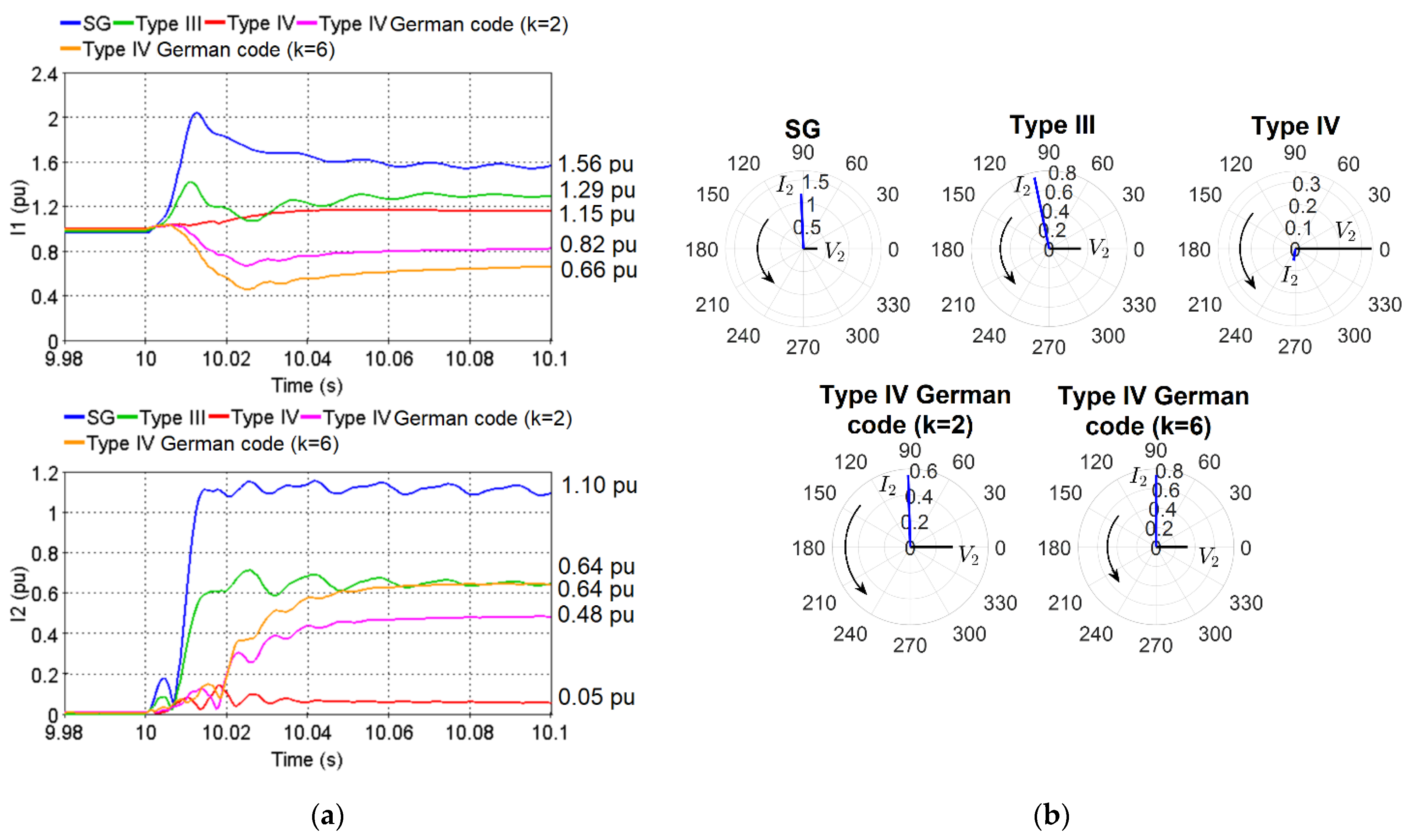
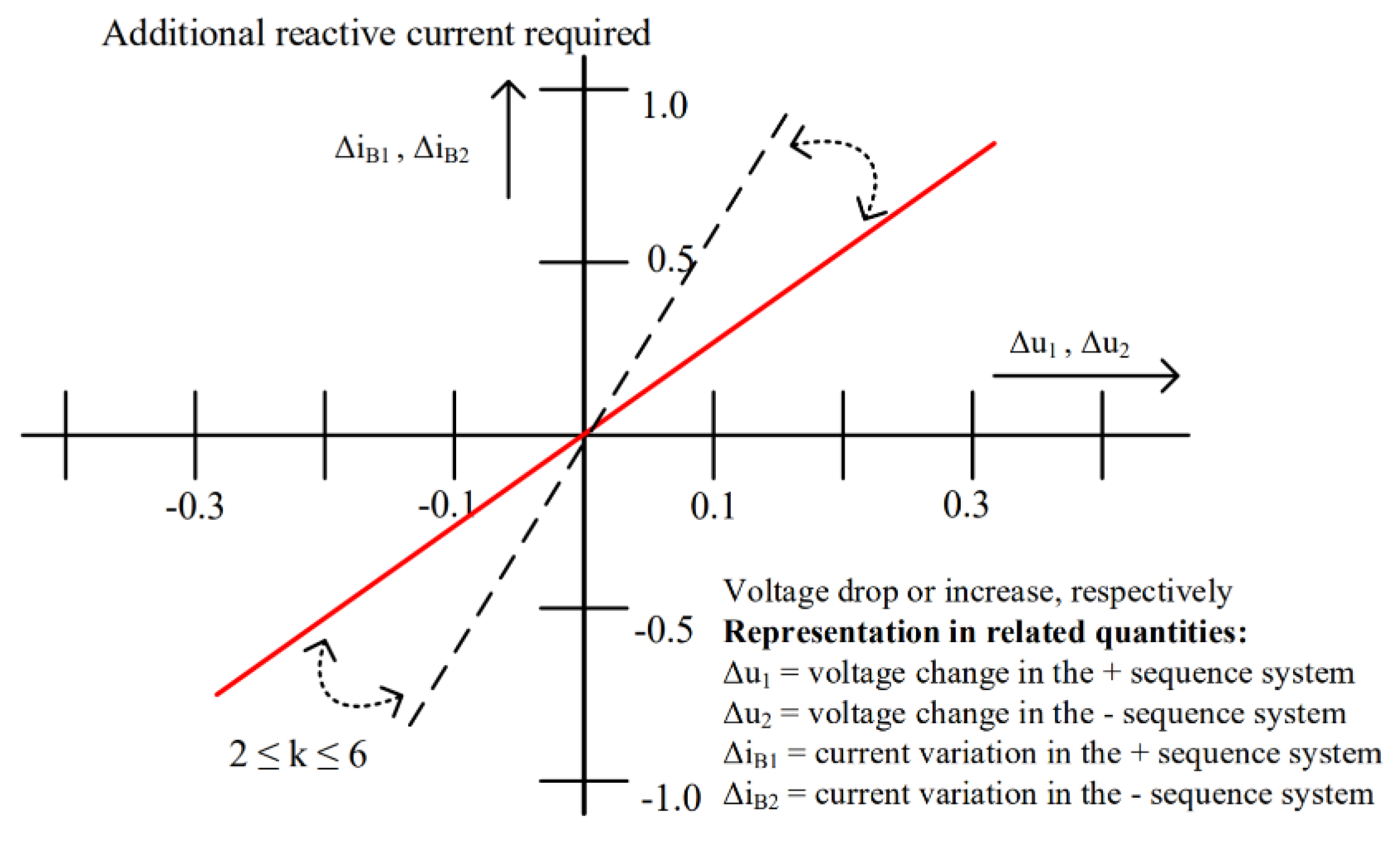
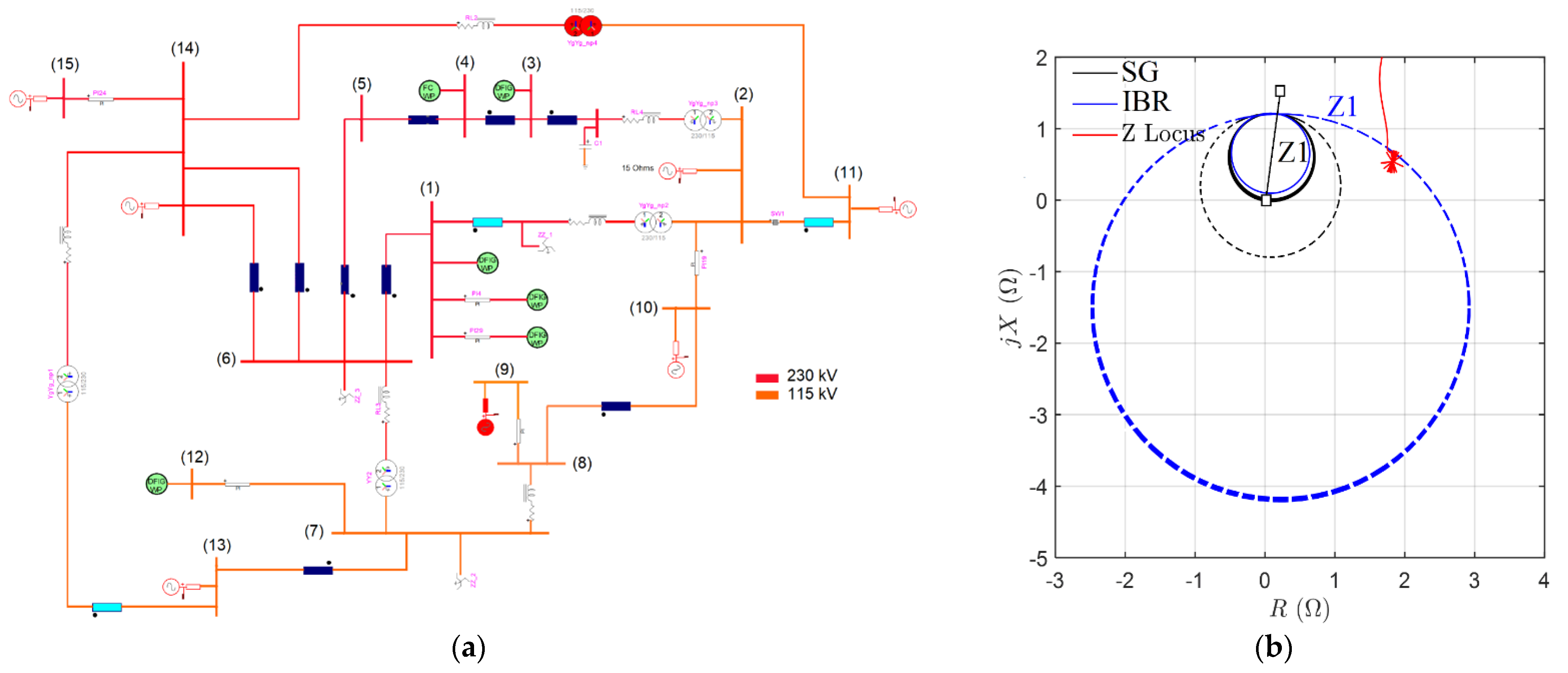

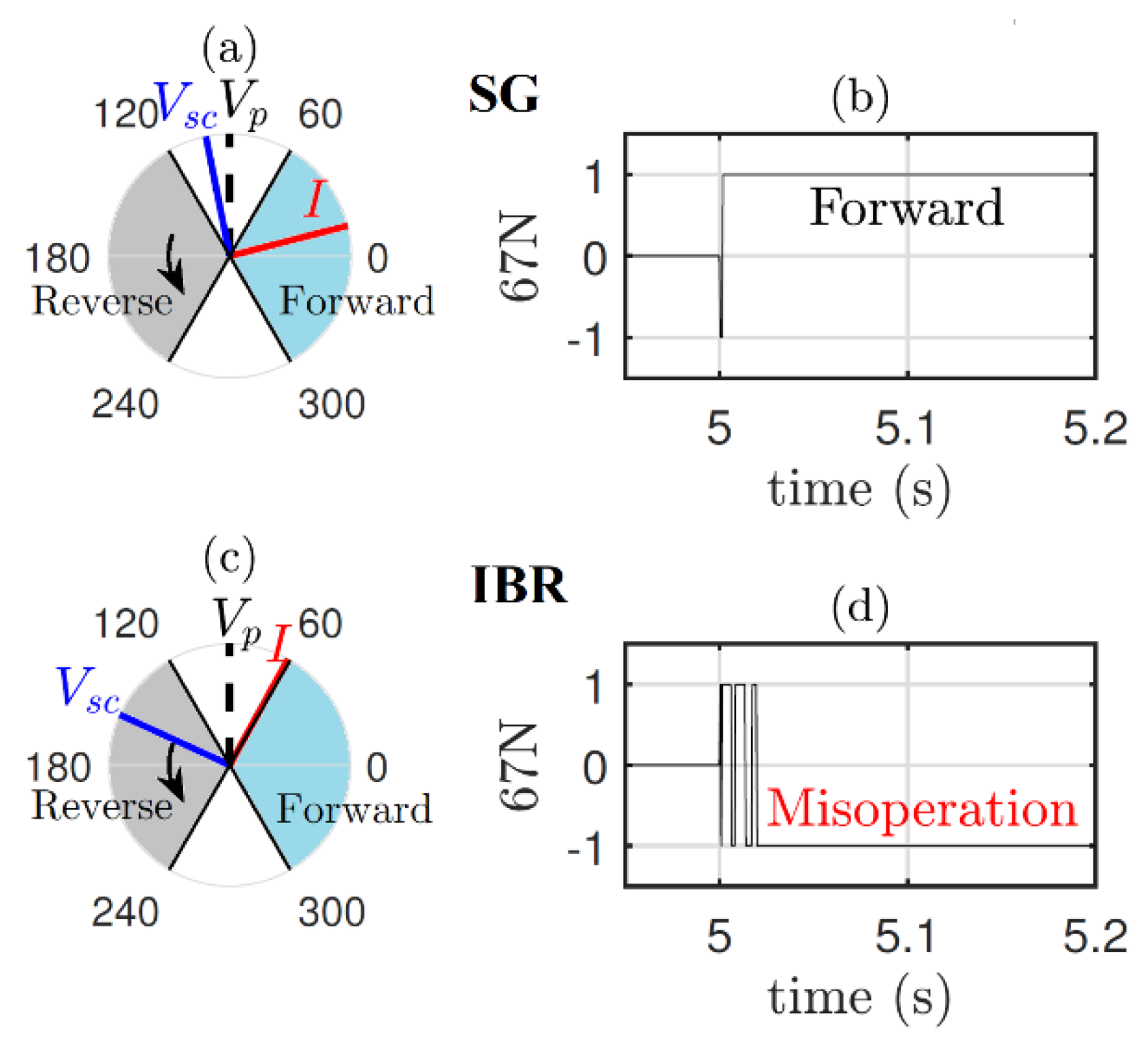
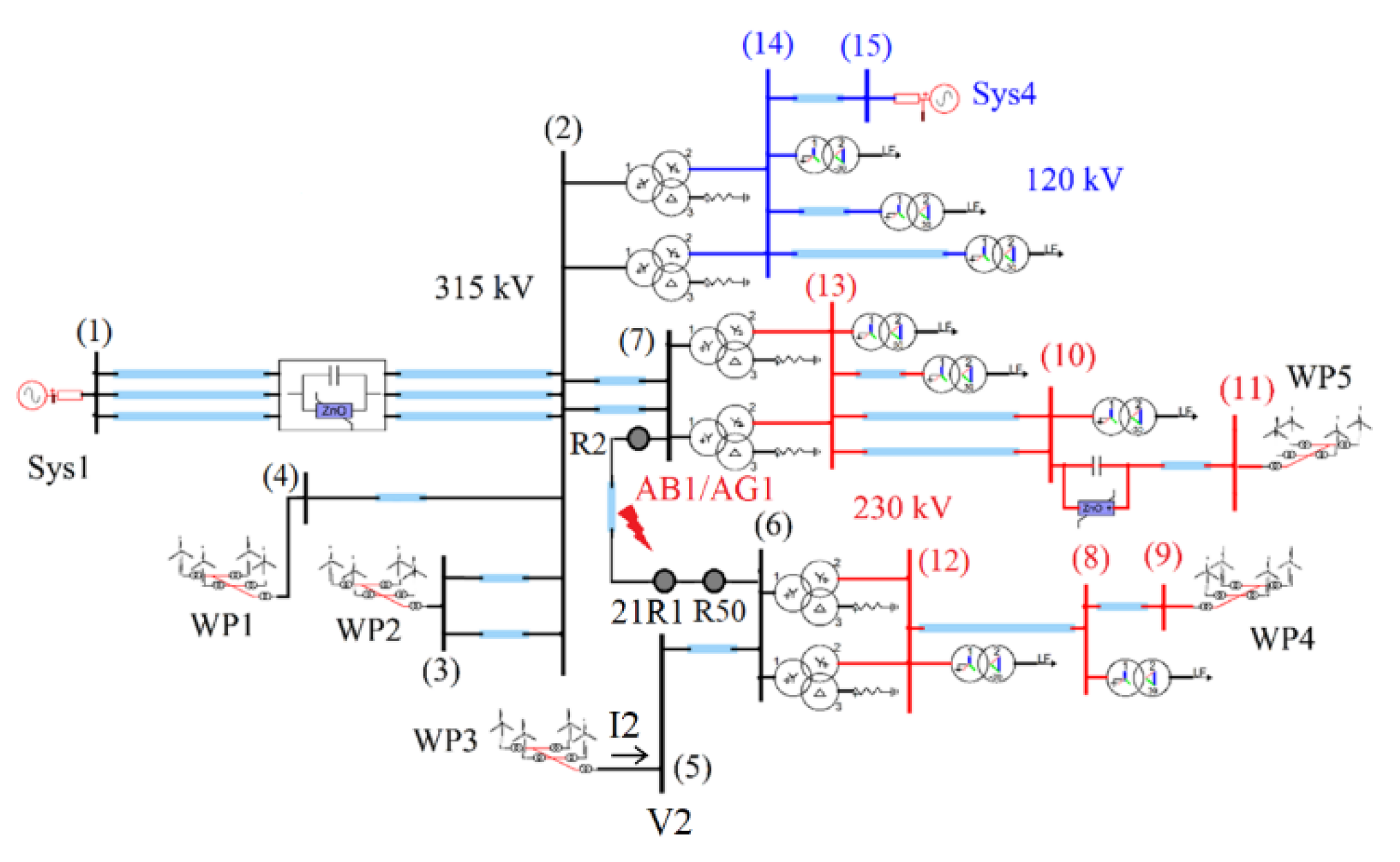


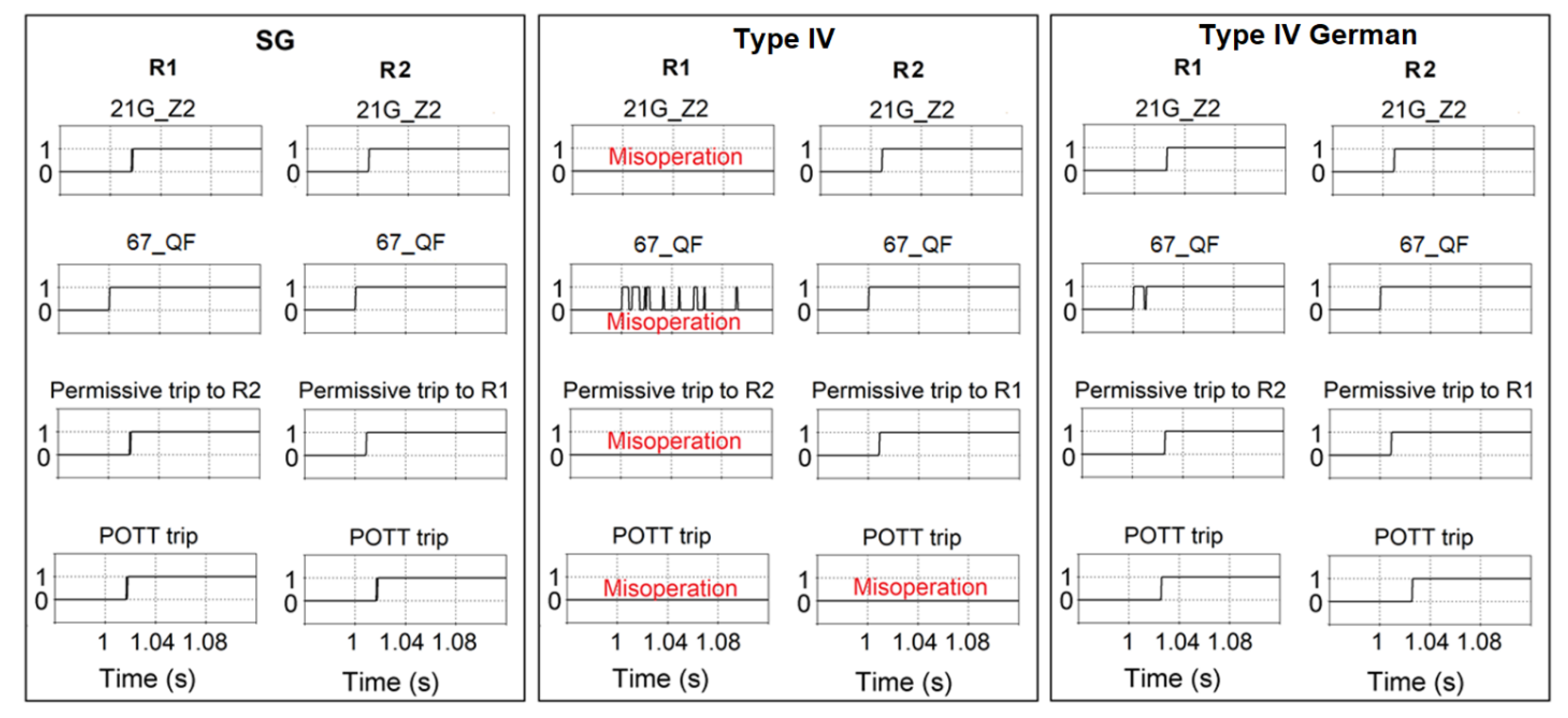
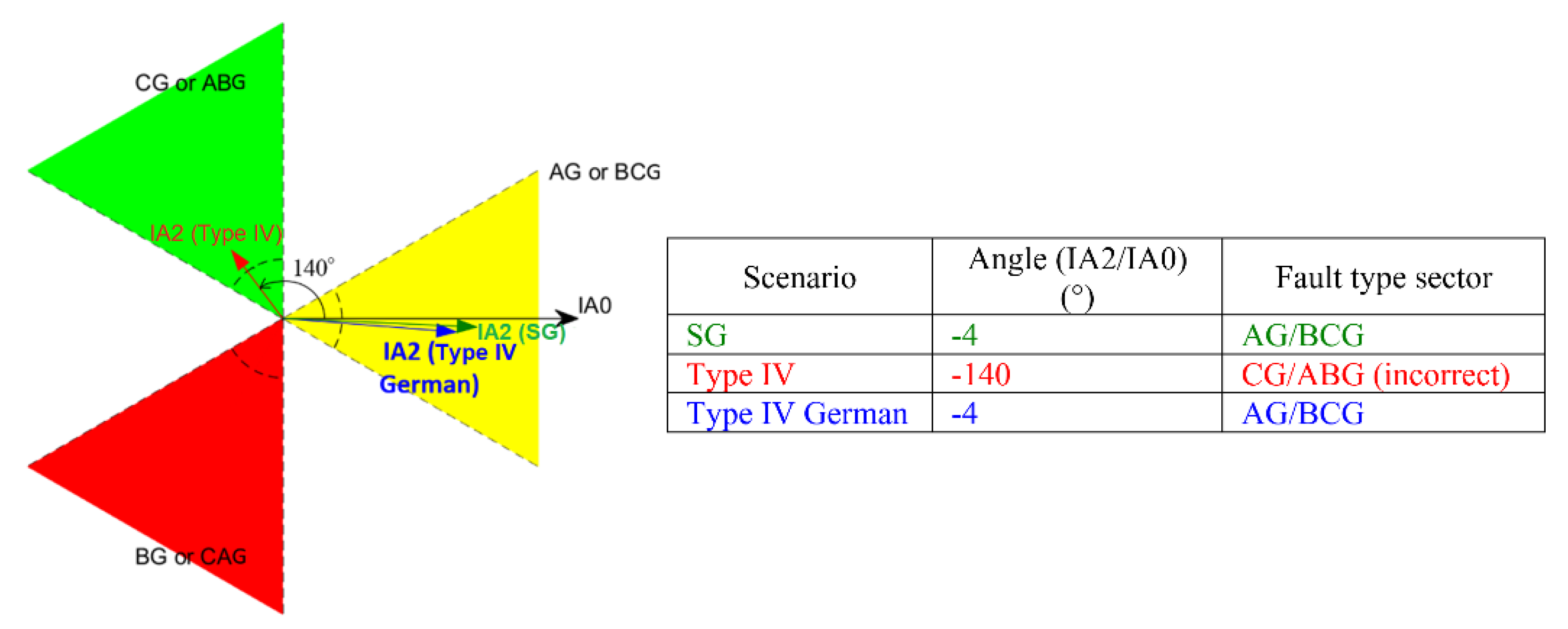


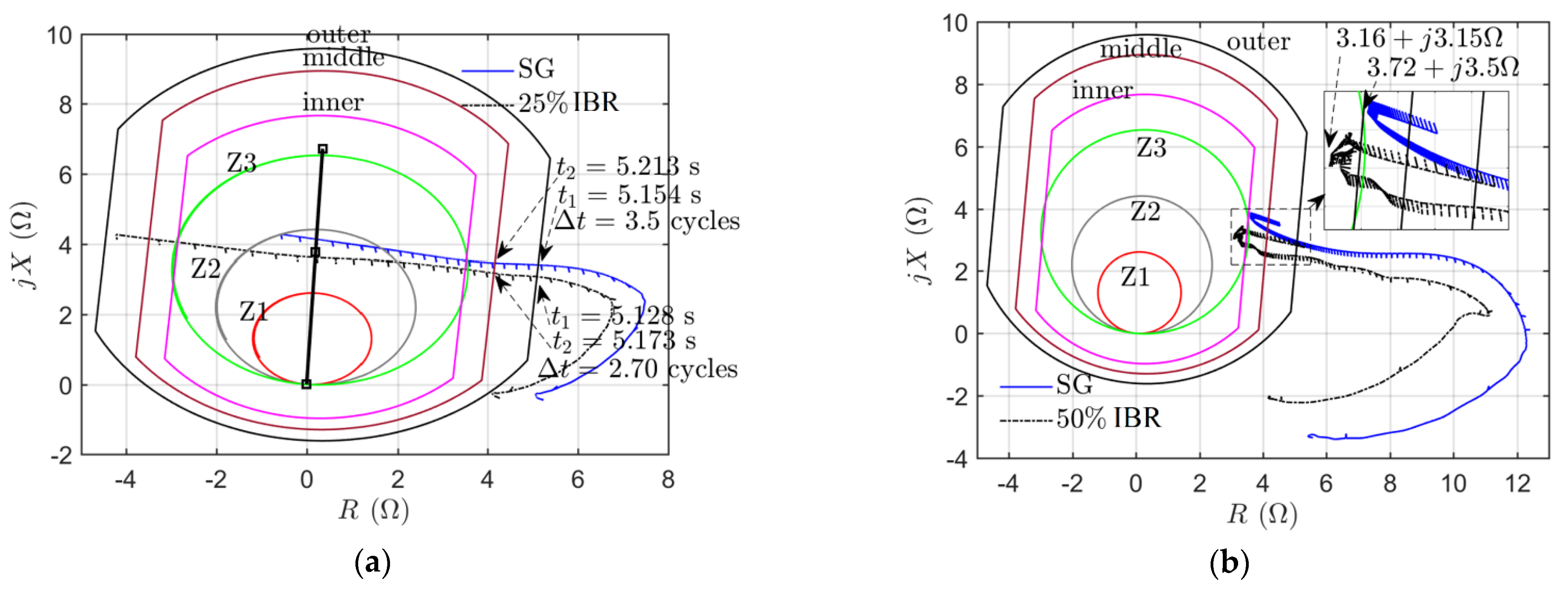
| After 5 Cycles | ||
|---|---|---|
| V1 (pu) | I1 (pu) | Angle (I1/V1) (°) |
| 1.00 | 1.00 | 0.00 |
| 0.90 | 1.13 | −10.20 |
| 0.80 | 1.15 | −20.35 |
| 0.70 | 1.15 | −31.45 |
| 0.60 | 1.15 | −44.08 |
| 0.50 | 1.15 | −60.41 |
| 0.40 | 1.15 | −90.00 |
| 0.10 | 1.15 | −90.00 |
| Protection Function | Expected Protection Challenge Due to IBR | Potential Solution |
|---|---|---|
| Line distance protection | The lower amplitude of fault current under IBRs and lack of enough supervising current may lead to failure to trip. |
|
| The dynamically changing source impedance under IBRs may leads to unpredictable and inconsistent dynamic expansion of mho circle, thus reducing reach accuracy and increased risk of over- or under-reach. | Assessing the risk requires detailed three-phase analytic model simulation of the IBR control system. | |
| Memory-polarized zero sequence directional protection | Lack of inertia and faster IBR control response time may lead to a considerable shift in the phase angle of voltage during a fault, thus causing an incorrect directionality decision. |
|
| Negative sequence based directional ground fault protection | Lack of I2 contribution by IBRs may lead to lack of enough supervising I2, causing the element not to assert. |
|
| The changed phase angle of I2 under IBRs may lead to an incorrect directionality decision. |
| |
| Negative sequence overcurrent elements | Lack of I2 contribution by IBRs may lead to lack of enough supervising I2, causing the element not to assert. | Provide IBR dynamic I2 reactive current injection together with additional countermeasures to attain an acceptable level of overcurrent reliability. |
| Pilot Protection | A malfunctioning Directional Negative Sequence Overcurrent (67Q) element causes the impacted relay to communicate an incorrect permissive trip/block signal to the remote relay, leading to an incorrect trip decision. |
|
| Directional Comparison Blocking scheme (DCB) may have difficulty in sensing faults on its line due to low levels of fault currents produced by IBRs. |
| |
| LCD | The changed fault current patterns under IBRs may cause LCD to mistakenly classify an internal fault as external and fail to operate. |
|
| ROCOF | High IBR integration leads to larger system ROCOF events which are potentially sufficient to trigger the ROCOF protection system, leading to undesired tripping of embedded generation units with potentially destabilizing consequences of the network. | Increase the ROCOF setting. |
| Power Swing Protection | Reduced inertia under IBRs increases the rate of change of swing impedance vector, and the Power Swing Blocking (PSB) function may mistakenly interpret such faster swings as a system fault and fail to declare a power swing condition. | Reduce the time delay setting of the PSB function based on the fastest swing in presence of IBRs. |
| IBRs may impact the impedance trajectory of the most severe stable swing, potentially causing the Out-of-Step-Tripping (OST) to misinterpret a stable swing as unstable. | Modify the settings of the OST element based on the most severe stable swing under IBRs. | |
| The dynamically changing source impedance under IBRs may change the optimal location for implementation of the OST. | Recalculate the location of optimal location of OST under IBRs. |
Publisher’s Note: MDPI stays neutral with regard to jurisdictional claims in published maps and institutional affiliations. |
© 2021 by the authors. Licensee MDPI, Basel, Switzerland. This article is an open access article distributed under the terms and conditions of the Creative Commons Attribution (CC BY) license (http://creativecommons.org/licenses/by/4.0/).
Share and Cite
Haddadi, A.; Farantatos, E.; Kocar, I.; Karaagac, U. Impact of Inverter Based Resources on System Protection. Energies 2021, 14, 1050. https://doi.org/10.3390/en14041050
Haddadi A, Farantatos E, Kocar I, Karaagac U. Impact of Inverter Based Resources on System Protection. Energies. 2021; 14(4):1050. https://doi.org/10.3390/en14041050
Chicago/Turabian StyleHaddadi, Aboutaleb, Evangelos Farantatos, Ilhan Kocar, and Ulas Karaagac. 2021. "Impact of Inverter Based Resources on System Protection" Energies 14, no. 4: 1050. https://doi.org/10.3390/en14041050
APA StyleHaddadi, A., Farantatos, E., Kocar, I., & Karaagac, U. (2021). Impact of Inverter Based Resources on System Protection. Energies, 14(4), 1050. https://doi.org/10.3390/en14041050







